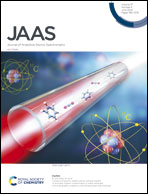Compound specific stable carbon isotope analysis of aromatic organic contaminants in water using gas chromatography coupled to mid-infrared laser spectroscopy†
Abstract
Compound specific isotope analysis (CSIA) provides a valuable tool to identify multiple sources and to elucidate the underlying transformation processes of different organic contaminants in complex environments. Different from conventional isotope ratio mass spectrometry (IRMS) based techniques, a mid-infrared laser based analytical approach is newly developed in this study for gas chromatography (GC) separation and carbon CSIA of aromatic organic pollutants in water. The accuracy and precision of our method are evaluated by determining δ13C values of benzene, toluene, ethylbenzene and 1,2,4-trimethylbenzene dissolved in water. Headspace samples at microgram-per-liter aqueous concentrations are analyzed and the obtained precision is higher than 0.3‰ for all the target compounds. The accuracy of our method is cross validated by comparing with the conventional IRMS measurements, where the differences in δ13C values of the target compounds are within 0.5‰. The validated approach is applied to monitor the temporal trend of the carbon isotopic composition of 1,2,4-trimethylbenzene in drilling fluids collected during horizontal shale drilling processes. The increasing δ13C trend indicates carbon isotope sensitive processes likely caused by subsurface transformations of 1,2,4-trimethylbenzene. To the best of our knowledge, this is the first validated optical carbon CSIA approach proven to be applicable for a wide spectrum of organic compounds.



 Please wait while we load your content...
Please wait while we load your content...